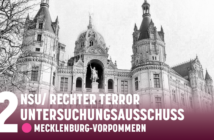After experts concluded the final examination of the accused Carsten S., various attorneys offered remarks on S.’s testimony and Holger G.’s statements, which was read aloud. Wohlleben’s defense attorneys challenged the value of S.’s testimony on the grounds of his refusal to answer their questions and concluded with a request that her client be released.
The trail day begins at 9:50. After roll call Götzl announces that the accused G.’s defense had declared that G. could provide more details because of Carsten S.’s testimony. However, that still has to be worked out with the client. Götzl asks S. if he would answer questions from Wohlleben’s defense, if the court asked the questions. S.’s attorney Jacob Hösl said: “He has to think about it.”
Afterwards, Götzl read aloud the judicial notes from the examination of Carsten S. on the 4th and 5th of June 2013 for the psychiatric expert professor Leygraf. Leygraf was not present on these trial days (see protocols for the 5th and 6th trial days). After the notes were read aloud, professor Leygraf asked S. some questions. Amongst other things, he asks him about a situation, in which S., during a police check, was given back his identification with the statement “Mr. S., from New Delhi.” S. describes the situation again (see protocol for the 6th trial day). Leygraf goes into the subject of S.’s nicknames, “Indian” and “baby carrot.” He would like to know, how S. got the nickname “baby carrot.” S.: “Flo had said that I drink too much carrot juice and that’s why I have a darker complexion.” Than professor Saß, professional witness for Beate Zschäpe [Zschäpe does not speak with Saß]. Saß would like to know how the relationship between Mundlos, Böhnhardt and Zschäpe was, when S. was in contact with the three. S. says he couldn’t detect any difference between the three. Also the impression wasn’t given that the three hadn’t seen each other for a long time at the meeting in Chemnitz. He couldn’t detect any hierarchy, and they all vocally contributed. Then Saß would like to know how S. would describe the nature of the contact they had with each other, if it was friendly or businesslike. Subsequently, Zschäpe’s defense began a cascade of objections. Attorney Stahl says the questions are speculative. Saß points out that the psychiatric technique for questioning is different then the judicial and concretized his question in the sense of if S. ever perceived an “argumentative leadership.” Here, Attorney Sturm intervenes. She says that S. had already admitted that he had exchanged altogether seven or eight sentences with her, including all meetings with Zschäpe both before and after going underground. From that, S. could only make an evaluation through “extremely slight connecting circumstances.” Saß points out that S. studied social education, and in this respect had some experience with the interpersonal and could perhaps evaluate the meeting in Chemnitz as a result. Sturm replies that S. first studied later and the expert witness should ask about facts. Judge Götzl also engaged himself in the following debate. He asks Sturm: “Do you mean to say that certain circumstances may no longer be scrutinized?” Ultimately, S. answers: “Naturally, I spoke at first only with the both of them, then we were briefly four, and then she went away again. I don’t remember anything about it.” When asked by Saß, S. explained the signature on the papers that he brought with him. All three probably signed them, but it was not further discussed. It was probably clarified over the phone beforehand. With this, the examination of Carsten S. ended. Afterward, the participants in the proceedings have the opportunity to offer remarks about on S.’ testimony, following § 257 StPO. None of the accused would like to personally speak out. On the side of the co-plaintiffs, attorney Mohammed begins his remarks, which Götzl, however, quickly interrupts when Mohammed begins to make summary arguments and to discuss if S. exhibited the intention to kill. Götzl asks if attorney Mohammed wants to make summary arguments. Mohammed should reexamine his remarks and think if he wants to offer them as is. Götzl interrupts the session for lunch.
After the break, Attorney Mohammed sticks by the decision to give his summation as he had planned. Götzl interrupts him again and asks whom he represents and how he came to the idea that he wanted to speak to S.’s culpability. Mohammed: “With this argument, the co-plaintiffs from Keupstraße are not allowed to pose a single question.” Disquiet prevailed amongst the representatives of other co-plaintiffs. Co-plaintiff representative attorney Behnke appealed to Mohammed, once again to rethink his speech “in the interest of everyone.” Ultimately, Mohammed said he would consider it again. Then attorney Link, lawyer for the son of the murder victim Ismail Yaşar, offered her interpretation. It is a relief for the son that S. answered so exhaustively. Regardless, questions remain open. “Please think about it again, if the three really did order a weapon with a silencer.” Only then does it make sense. The three could have also committed a bank robbery without the accused S.’s help.
Then follows attorney Hoffman, representative of one of the victims in the nail bombing in Köln in 2004. According to Hoffmann, S. has, on the one hand, seriously incriminated himself by testifying that the weapon hand-off happened after he learned “the two Uwes already had weapons, after they had already committed some kind of bombing.” When even S., the young helper, was told about these things, one must ask how much it suggests that older members from the scene were also told things. On the other hand, in contrast with the precise details in the testimony in reference to the weapons hand off, “in other parts a dispute, a not-wanting-to-admit, and holes in the memory,” which potentially void the apology. For S., the hand off of the Ceska sits at the heart of his sense of guilt. Here, he gave credible testimony, where S.’s testimony was so disappointing on other points. Attorney Alkan once again goes into S.’s refusal to answer questions from Wohlleben’s defense. S needs to, in order to be believable, also “bare himself completely” [see protocol for the 10th trial day]in front of Wohlleben’s defense. The second is about how to judge the explanation about the flashlight in regards to S. Alkan: “It begs the question, why there was this readiness, if S. was more involved than is acknowledged.”
Next, Wohlleben’s defense attorney Olaf Klemke speaks against the admissibility of Carsten S.’s testimony. In the process, he refers to, as he has earlier already, the European Convention on Human Rights and the jurisdiction of the European court. By S. refusing to answer questions from Wohlleben’s defense, Wohlleben has no chance to confront and question the accuser. Carsten S. is the only evidence against Wohlleben. A verdict may not be propped up alone, however, on the testimony of a co-defendant that the defendant or his defense team could not examine through immediate examination.
Subsequently, Wohlleben’s attorney Nicole Schneiders reads aloud remarks on S.’s testimony. The claim that S. will not answer questions from Wohlleben’s defense because he doesn’t want to offer a platform to the defense and Wohlleben should first answer questions, should be judged as a self-serving declaration. Wohlleben’s defense has an extensive catalogue of questions, but has had the right to ask questions taken away. S. has ascribed a central roll to her client, but himself merely an intermediary activity. Then she names several allegedly contradictory pieces of information from S.. S. could not say with certainty that the weapon hand off was indeed the weapon used in the crimes of the “so called Česká murder series.” Also, the imprecise chronological placement fosters, according to Schneiders, doubt about the ability of the testimony to stand up under pressure. Here, she discusses that S. had shared that he sat together with the three in a café in the “Galeria Kaufhof” in Chemnitz. The “Galeria Kaufhof” in Chemnitz wasn’t there until first in 2001. At the time, there was only a department store in the vicinity of the train station, and it only had a standing café. [Note from NSU-watch: On this subject, S. had already said to one of the co-plaintiff’s representatives on the 10th trial day: “I don’t remember a Galeria Kaufhof. I know that from Düsseldorf. It was more this feeling: department store, café.”] From the aforementioned, Schneiders comes to the conclusion that the weapon hand off could not have had to do with the weapon used in the commission of crimes. Therefore, according to Schneiders, there remains no strong suspicion against Wohlleben of having committed a crime. The defense requests that the arrest warrant for Wohlleben is immediately rescinded and he be released. Then attorney Stahl, Zschäpe’s defense, reads aloud an explanation about the testimony of Holger G.. The federal public prosecutor’s accusations against Stahl’s client are heavily based upon upon the testimony that G. gave in the interrogations by the BKA, GBA and to the investigative judge from the federal court. Consequentially G.’s testimony enjoys great significance here in the main trial. It is therefore “unfortunate” that G. only freely spoke about himself and otherwise merely read aloud written remarks. This is indicative, moreover, that the remarks are not G.’s own, but rather were written by his lawyer. This is not in inherently objectionable, but does impinge on the legal relevance of the remarks. Details are not removed from the remarks, they remain “to say it figuratively, superficial.” Because G. mostly speaks in his remarks about “the three,” individual actions and not specific people are designated. This doesn’t change that G. says he always meant all three people, otherwise he mentions when someone was not present. The remarks partially contradict the GBA’s indictment, primarily when G. reluctantly speaks in reference to discussions about the “armed struggle” (see protocol from the 7th trial day). Moreover, the information G. freely gives about himself is partially contradictory, for instance when he states that he was not suffering from mental illness and then concedes that he had visited therapy for a gambling addiction. Ultimately, G. pointed out himself that ability to remember things in reference to chronological sequences suffered because of his drug use. All in all, the testimony from G. can have no legal validity in the court proceedings. Attorney Klemke also adds in a brief remark about G.’s testimony that the testimony “must be taken lightly.”
Then the co-plaintiffs’ representatives spoke to the remarks from Wohlleben’s defense. The claim to confrontational examination is directed at the court, and not at the participants in the trial. The court had, however, allowed the right to ask questions. S. had exercised his right to remain silent and in the same manner that Wohlleben refused to testify. Apart from that, the case law does not end in the necessary exclusion of testimony, rather only the corresponding critical valuation. It is understandable from S.’s perspective that he does not want to build a platform for Wohlleben, after all, attorney Schneiders was in the NPD. In reference to the remarks about the testimony from Holger G., it is still to be determined that G. is not the only evidence against Zschäpe.
Federal public prosecutor Diemer says that the GBA will speak to the applicability of Carsten S.’s testimony at another time.
Afterwards Götzl announces that Zschäpe and Wohlleben’s defenses’ requests, to stop the trial because of irresolvable procedural obstacles (see the protocol from the 5th trial day) are denied, and he reads the justification aloud.
Next, the court turned to the question when the 400-500-person list that was advertised by the federal prosecutors office, with people from the NSU milieu would be presented. The listed was previously known as the “129er” list [see protocol from the 8th trial day]. It was intended for this week. Additionally, it was inquired if the federal prosecutors office would lead a follow-up investigation after the seizure of Zschäpe’s letter to the prisoner Robin S.. It is currently not known if Robin S. from Dortmund already had contact with Beate Zschäpe, Mundlos or Böhnhardt before he was imprisoned either personally or through a third party. The federal prosecutors office said in that regard that they see no point of reference for an investigation into Robin S.
At 14:35 the session ended. On Monday, the 24th of June it will continue
Co-plaintiff representative Peer Stolle summarizes the trial day:
“Wohlleben’s defense’s objections against the admissibility of Carsten S.’s testimony is legally and effectively unsustainable. A defendant can in principle decide themselves if he will answer questions. […] It’s true what Zschäpe’s defense said, that Holger G.’s remarks that were read aloud leave many open questions. We would have also welcomed a chance to examine him. Nevertheless, it is not so that Holger G. is the solitary chief-incriminating evidence. There is a myriad of further objective evidence that attest to Mrs. Zschäpe’s complicity.”
Attorney Sebastian Scharmer remarks regarding the hitherto unexecuted follow-up investigation:
“It is absolutely incomprehensible that the federal prosecutor’s office has apparently thus far not considered this angle of investigation. If there is more behind it than just a pen pal from jail, then it must be urgently clarified. According to media sources, Robin S. was, at least before his imprisonment, well integrated into the Dortmund neo-Nazi scene. The weapon used in his crime was delivered to him by the informant Sebastian S.. Robin S. is said to have belonged to the ‘Oidoxie Streetfighting Crew’ scene, a violence-ready group around the band ‘Oidoxie,’ who have, among other things, published songs with calls to armed struggle according to the ideas of Combat18. […] With their conduct the federal prosecutor’s office provokes further understandable mistrust amongst the co-plaintiffs. How they came to the conclusion that this clue is not important without the appropriate investigation remains nebulous. It would be easy for the federal prosecutor’s office to deploy the immense investigative apparatus that is at their command to clarify this – and to confirm their suspicion that Robin S. had no connection to the three.”
Addendum:
The location of the weapons hand off was also a theme already on the 10th day of trial. Nevertheless, Carsten S. never settled on a specific business, instead he only described the place. Here is the protocol from the co-plaintiff’s representative:
1. Question: “Where was the conversation before the weapon hand off?”
Answer: A department store with a café. I don’t know my way around Chemnitz’s inner city. I don’t remember a Galeria Kaufhof, but I know one like it from Düsseldorf and had a mental image of it.”
2. Then a phone conversation. I should bring the weapon to Chemnitz. I don’t know if Wohlleben or I phoned. Then I went by train to Chemnitz. The two Uwes picked me up at the train station. I don’t know if it was fall or spring, because I was cold. I had an ACAB hoodie on. One of the Uwes told me to take it off. I went with them into a shopping center (Galeria Kaufhof or something similar) with a café.


